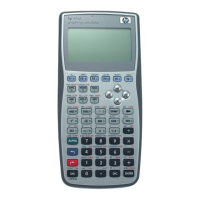4-34 Computer Algebra Commands
Level 2/Item 3: The diagonal representation of the quadratic form.
Level 1/Item 4: The vector of the variables.
Flags: Exact mode must be set (flag –105 clear).
Numeric mode must not be set (flag -3 clear).
Radians mode must be set (flag –17 set).
Example: Find the Gaussian symbolic quadratic form of the following:
x
2
2axy+
Command: GAUSS(X^2+2*A*X*Y,[X,Y])
Result: {[1,-A^2], [[1,A][0,1]], -(A^2*Y^2)+(A*Y+X)^2,[X,Y]}
See also: AXQ, QXA
GBASIS
Type: Command
Description: Returns a set of polynomials that are a Grœbner basis G of the ideal I generated from an
input set of polynomials F.
Access: Catalog, …µ
Input: Level 2/Argument 1: A vector F of polynomials in several variables.
Level 1/Argument 2: A vector giving the names of the variables.
Output: Level 1/Item 1: A vector containing the resulting set G of polynomials. The command
attempts to order the polynomials as given in the vector of variable names.
Flags: Exact mode must be set (flag –105 clear).
Numeric mode must not be set (flag -3 clear).
Radians mode must be set (flag –17 set).
Example: Find a Grœbner basis of the ideal polynomial generated by the polynomials:
x
2
+ 2xy
2
, xy + 2y
3
– 1
Command:
GBASIS([X^2 + 2*X*Y^2, X*Y + 2*Y^3 – 1], [X,Y])
Result: [X, 2*Y^3-1]
Note this is not the minimal Grœbner basis, as the leading coefficient of the second term is not
1; the algorithm used avoids giving results with fractions.
See also: GREDUCE
GCD
Type: Function
Description: Returns the greatest common divisor of two objects.
Access: Arithmetic, !ÞPOLY L
Input: Level 2/Argument 1: An expression, or an object that evaluates to a number.
Level 1/Argument 2: An expression, or an object that evaluates to a number.
Output: The greatest common divisor of the two objects.
Flags: Exact mode must be set (flag –105 clear).
Numeric mode must not be set (flag -3 clear).
Example: Find the greatest common divisor of 2805 and 99.
Command:
GCD(2805,99)
Result: 33
See also: GCDMOD, EGCD, IEGCD, LCM

